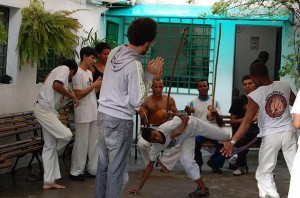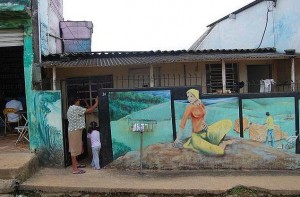Background: community media in Brazil
Background: community media in Brazil
This page aims to contextualize the VCU.br project. It outlines the media landscape in Brazil – both commercial and community-produced – and suggests ways in which community media can challenge the mainstream.
Community Media in Brazil 
Video Volunteers decided to pilot this livelihood program in Brazil, in large part, because of the country’s thriving community arts scene. Brazil has one of the greatest public investments in community arts and culture of any country in the world. There are dozens of groups teaching video, hip hop, graffiti, circus skills, carnival-related arts and digital media to youth from favelas.
The VCU.br project was started in Brazil because, whilst there was lots of wonderful community arts projects, there was little focus on livelihood and financial sustainability – this was a gap that needed to be filled. To read more about this, check out the page on media entrepreneurism.
It is clear the Brazilian government is highly committed to supporting community arts and culture. As a key indicator of this, the minister of arts and culture was the famed singer Gilberto Gil. Given that he is one of the most revered celebrities in the country, this draws tremendous national attention to the government’s arts and culture programs. There is a 3% tax break for corporations that support the arts. In short, there is a significant amount of funds available for NGO media programs.
The quality of community arts work is generally very high. Several of the NGO programs have been started either by famous directors (for instance, Cinema Nosso which grew out of the City of God), TV producers (Instituto Criar in São Paulo, which was started by a Globo Executive) or musicians (ie, Afro Reggae, started by a hip hop artist.) Therefore, lots of this community art work has been seen on TV, won awards, and one project even resulted in a feature movie deal. Community produced art and media is an established part of Brazil’s colorful cultural landscape.

Community Media in São Paolo
Most community media programs existing in the São Paulo area work to empower youth to fight dominant stereotypes about the favelas. Favelas are labelled as areas of high crime and violence. This powerful imagery influences the way São Paulo’s downtown residents think about, and react to, the favelas and their residents.
These stereotypes give rise to a vehement desire among favela residents to counter such misconceptions. Yes, there is crime. Yes, there is poverty. But, there is also a wealth of creativity, passion and optimism. It is this vitality that feeds into the numerous community media programs, as youth are given a space to tell their own stories.
Brazil’s National Media: The Role Community Media Can Play in Breaking Down Barriers
Brazilian media is dominated by a single, private, nation-wide television station called Globo. This station features dramas, news, and entertainment television. Indeed, the country’s media consumption habits are largely unified: newspaper readership is extremely low. Ninety percent of households receive terrestrial television (again, with Globo as the dominant channel). Few have cable television options.
This monopoly goes largely unchallenged. Six family companies control the majority of all entertainment and media in the country. Further, there is no controlling mechanism in place in Brazil to limit the market share of media moguls. Thus Globo is like the New York Yankees of Mediacom companies: there is no ceiling on who or what they can buy.
Community media: an alternative to media hegemony?
Community media plays a distinct role in redefining identities in Brazil. This is in contrast to India and Africa (poorer parts of the world) where the need of the hour is information on critical issues. By comparison, because racism is such a huge problem in Brazil, and misrepresentation of the favelas persists, as mentioned above, the focus of media activism has been to empower people to make their own images to counterbalance this. Parallels can be drawn with non-profit media in the United States which is also often about combating stereotypes.
The media hegemony in Brazil creates a large obstacle for the many local and community-funded art and media programs. Whilst content is produced abundantly, distribution is severely curtailed as a result of Globo’s domination. The widespread distribution of community media (and other independent programming) is difficult throughout the world. The key point to be made with regard to Brazil is that there is no mandate for public and/or independent stations – there is no BBC or PBS and few cable channels. This problem is compounded by a lack of bandwidth – there is literally no space left to broadcast alternative media.

Currently, there is a movement to diversify Brazilian media and decentralize the powerful companies controlling the market. The threat posed by Globo and its allies is very real. The danger here—as with the danger in any media monopoly—is that media conglomerates control far more than just the airwaves; they control public opinion.
If the only image broadcast across Brazil of favelas is that of violent young gang leaders and their reckless followers—this will dominate the public’s view of the favelas. And this in turn will influence policies and programs targeting the favelas.
This brings us directly back to the key role community-produced content plays – it combats the stereotypes the mainstream media perpetuate. However, unless other channels for other voices are opened up in Brazil, the misrepresentation of São Paulo’s favelas will persist. The problem is, if no one is seeing these images in the mainstream, how useful are they? Of course these images are impactful for the personal transformation of the producers but their wider impact is limited.
Focusing on livelihoods, and creating a generation of Brazilian youth from favelas working in the mainstream, attacks the problem from the inside. The images being depicted in the mainstream need to change completely, not just be challenged with alternatives.
The importance of combining community-produced content with viable livelihood options is clear. Both elements are vital if the media hegemony in Brazil is to be combated; it needs bright, entrepreneurial young people with skills in media production to take on the status quo and thus the idea for VCU.br was born.

